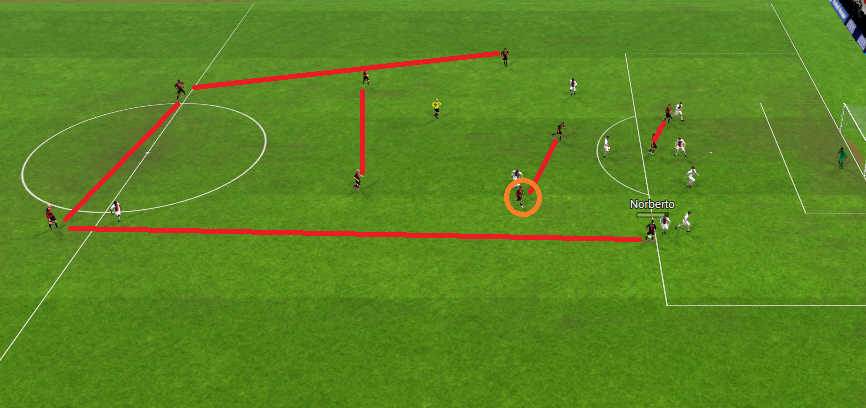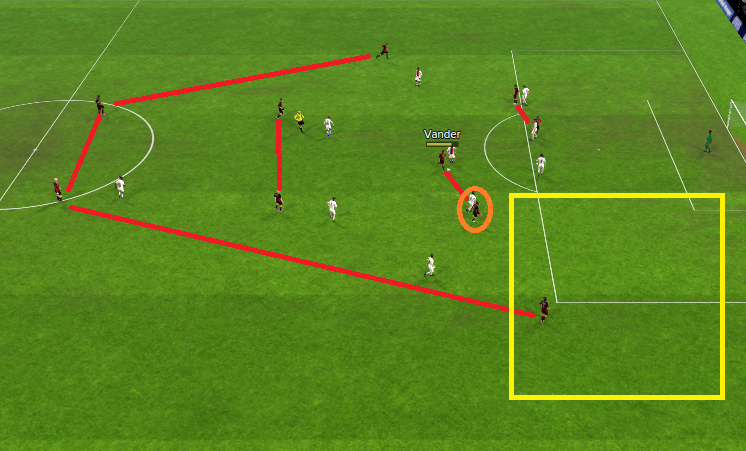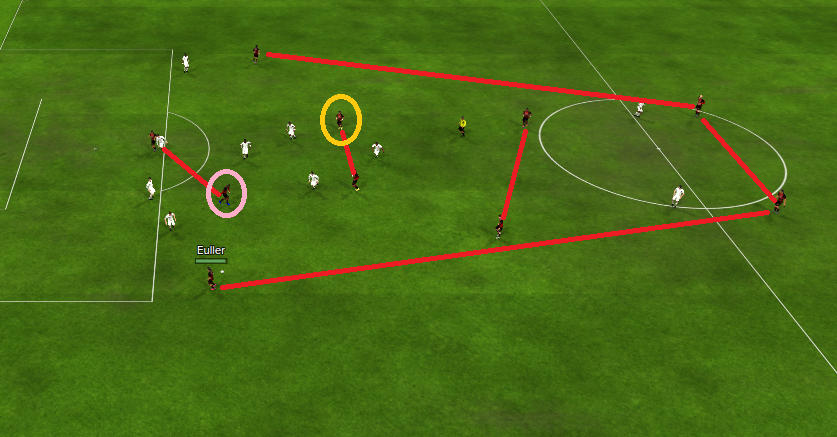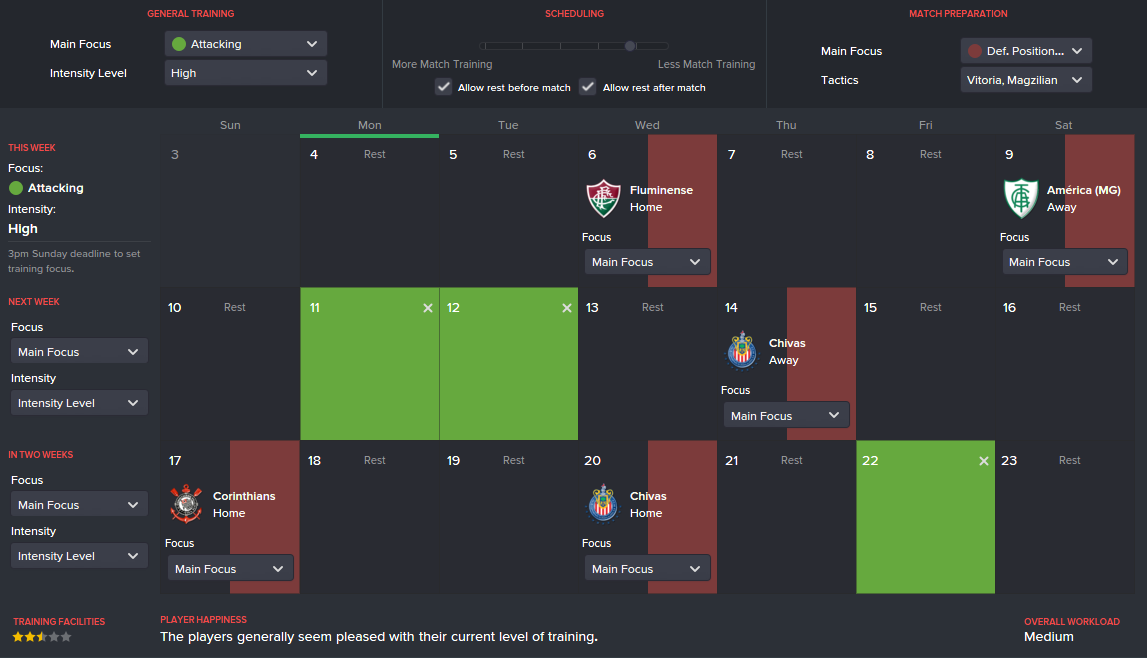I think I have this blogging game sussed now – less from me, more from other people! Following the widely acknowledged brilliance of @www.thehighertempopress.comfmanalysis’s “Virtually Vallecano” I am delighted to bring another new writer to join The Higher Tempo Press. Paul Marshall is a good friend of mine and we often have varied tactical discussions. Finally I have convinced him to put pen to paper. This is Paul’s first ever tactical article, and immediately I am reminded why I stick to story telling. Read on, you’ll really enjoy it. #WeAreTheCommunity – oh, and five points to anyone that can get the reference in the title…
When FM16 came out I took a while to decide on my first big save, what I wanted to do, who I wanted to manage and what tactics I wanted to implement. When it comes to the FM series I don’t like using “standard” tactics, even if tweaked with player roles and instructions to make them play one way or another, I find them boring. I want to be a Pep, a Bielsa, a Lillo. A maverick. I also love the ideology of Universality in Football. So I combined the two approaches and decided upon Vitoria Setubal in the Primera League in Portugal. I created a 3-1-3-2-1 based on Fluid play and standard player roles, meaning it was easy to learn, easy to implement and easy to play. I won 5 trophies in 2 seasons before moving on to Barcelona, winning another 4 with a tweak of that tactic before getting bored and quitting and moving to Schalke before experiencing crash dumps and a corrupt save and then quitting the save altogether. It was too easy really. I shouldn’t have left Setubal for Barcelona. I was building something special in Portugal.
So, determined not to make the same mistakes and after loading and quitting various saves in obscure leagues, just to get a feel of who or what I wanted to do next and after feeling zero inspiration, I thought I would head back to where all my most exciting saves from CM/FM of old have been… Brazil. I wanted a challenge, but not too much… I don’t like lower league football, I like developing youth. I chose EC Vitoria in Serie B. They have a famed academy with U20 and reserve teams chocked full of talent. They had no money either so this was going to be a real development save. They did have some players on loan, although I wasn’t sure how good they were. Oh, and they had a nice kit, like Flamengo’s, the red and black horizontal blocks. This is important as I want my saves to look nice!
OK, so there I am. In Vitoria, the island capital of the Brazilian state of Espirito Santo. It is November 2014 and the season has just finished. I have 2 months until the regional championships and cups start. What do I want to do here?
Well, as stated above, I don’t like using “standard” formations; you know the ones, the 4-2-3-1, 4-1-2-3 or 4-4-2 etc. I am in Brazil though, home of the 4-2-2-2 box formation, also where the 4-2-4 was used so beautifully in the 1970 World Cup. Neither tactic translates brilliantly into FM but I want to honour the style, the Samba style. So how can I use the 4-2-2-2 but stamp my personality on it? It should be said, I build a tactic that I think will work, and then find or train players to play within it. Flexibility is key for me. If you don’t fit the system, in the words of Lord Sugar, “you’re fired”…
I want it to start as one formation, transition to another and end the attack with yet another. I’d like it to defend as something else entirely as well if possible.
So let’s have a look.
The 4-2-2-2 Box uses a back 4 with attacking Full Backs, a pair of Defensive Midfielders, a brace of attacking Central Midfielders and deuce of Strikers. So this is where I started.
One role that I love in recent FM’s, more than any other, is the Wide Playmaker, and in FM16 they seem to have optimised it perfectly. It works now like Iniesta at his peak, dropping narrow dragging opposing fullbacks with him, opening space for an onrushing full back…
Ahh, the Brazilian Full Back. Who didn’t love Cafu, Roberto Carlos and Carlos Alberto, bombing forward to scare the bejezus out of opposing wide men? Imagine that, but with the opponents full back removed from the equation by following a man drifting from wide to narrow… that needs to go in to the tactic.
So, my first move was to move the right side Central Midfielder up and out to the Right Wing position. He was set to be an Advanced Playmaker on Support, with Sit Narrower, Cut Inside with Ball and Hold Up Ball as his instructions. Behind him I moved the Right Full Back up to the Wing Back slot and set him as a Wing Back on Attack. He was told to Stay Wider and Cross from the Byline to the Far Post. I want him attacking the space that the AP leaves behind, hopefully free of my opponents left sided full back.
I like my tactics to play one way on one side, and another on the other. I want to confuse my opponents. Also, if one approach on one side doesn’t work, let’s focus play down the other in the hope that that works. So, on the left…
…I set the Left Full Back to be pushed up into the Wing Back slot. I feel the WB roles work better than the FB ones. I asked him to Support the play, Sit Narrower and to Cut Inside with Ball. Why? I want to create numbers in the centre of the park, to break down counter attacks at source, should we lose the ball. That’s for another article to explain, there are pieces all over the internet that talk about Pep Guardiola’s desire to dominate the middle while still exploiting the flanks.
Ahead of him, I moved the left side Striker out and back to be an Inside Forward on attack. I want him kind of mirroring the AP on the other side, but being more attacking, joining the remaining striker, making diagonal runs and attacking the far post once the right side Wing Back crosses from the byline.
Next to the left Wing Back, sat in front of the DM strata, I want a central linking player. One who can take the ball from conservative Defensive Midfielders and link up the transitions. So, a Box to Box man. A dynamic runner, pretty one dimensional, but a perfect foil to the diagonal runs of the AP and IF ahead and wide of him. There is a reason I do not play this role centrally as opposed to offset to one side. It places the player closer to the half space and opens up diagonal passing options to the AP, RWB and DLF. It also reduces the chances of him being double marked by the opposing Central Midfield duo.
My Defensive Midfielders and Central defenders are going to start as standard DM and CD roles. I will tweak these as I see necessary. I like how the DM on support works and I want to only play with one playmaker, trying to stick to the principles of Universality and a Very Fluid Style.
Up front I want a Complete Forward. The Complete Forward role doesn’t work how I would like in game so I thought about what the other roles offer. I want the player to be a False 9, dropping deep, a Poacher on the end of crosses and a Trequarista who will drift wide left or right to overload the flank we are attacking down. I decided upon a Deep Lying Forward on Attack duty with Roam from Position set in the hope he will do as I describe above.
This is the result of all of the above:
Looks nothing like the 4-2-2-2 Box formation, right? Wrong.
I set the mentalities to Attacking and Very Fluid. In Brazil recently there has been a shift to more pragmatic approaches. An abundance of Defensive Midfielders in the Dunga mould have dominated the Selecao recently and players like Neymar, Ronaldinho are the rarity nowadays. I don’t want to follow that. I want skilful, attacking play, rolling the dice and gambling on a move (with that said, I do want balance, and as such my DM and CD roles are basic and will rely on strong, quick, simple players).
Very Fluid aids the way I want to the team to play as it will allow my players more creative freedom and will mean everyone takes part in all parts of the play, to be in Transition (attacking or defensive) most of the time.
Here are my Team Instructions:
Not much to say here other than I want the team to play Narrow to condense space in the middle of the park, to not allow the opponents standard 4-2-2-2 box space and Roam from Position, to allow coverage if a pressing defensive player is caught out of position. Perhaps I contradict myself my playing Narrow while Exploiting the Flanks. My thinking on this is that the Wing Backs should attack that awkward Half Space, making them harder to mark.
As for Opponent Instructions, I thought long and hard about this. As many people are, I’m a fan of Gegenpressing. In FM though, it doesn’t work properly. So I wanted another plan. I decided that key to success is the flanks, those flying Full Backs. If I could force the opponents to pass the ball out wide and then close down the wide men against the side line, we could regain possession and attack ourselves out wide. But how to achieve this? My thoughts on this, and they are a work in progress, were to force the middle men onto the foot that coincides with the side they are playing on, for example: MCL shown onto left foot, MCR onto right foot etc. Mixed with Tighter Marking this should force the midfielder to pass out wide as we will block off the passing inside with our tighter marking. If they are forced to turn and pass back we begin again on the central DM or CD. If they pass out wide it will trigger our press. This is where having an IF and AP wide allows us to double team with our Wing Backs onto their Full Backs. Sometimes the opponent even under hits the pass due to being shown onto their weaker foot. In this instance we are primed for an interception.
So how does it actually play?
Here is one attack, we are attacking left to right. You can see the pair of Defenders, the Pair of Defensive midfielders ahead of them in a strong box formation. Ahead of them, another pair of central players… But how? There should only be the Box to Box man, right? Well the right sided central attacking player is the AP (circled), having drifted in from the right wing. This is an Attacking 4-2-2-2 in anyone’s book. Out wide you can see the Wing Backs, the left sided WB won’t progress much further forward whereas the right sided WB will end this attack by sitting narrow and taking on a couple of opposition markers in the defensive line, making a quasi-front 3 with the DLF and IF. This attack didn’t end up with the opposition left back following my drifting AP, the opposition parked the bus and ended up with a back 7!
In this next example we can see the theory of drawing the opposition Left Back out of position, opening space for my Wing Back to attack and exploit.
The Ball is with Vander, my Box to Box Midfielder. Next to him (circled) is the Advanced Playmaker, sitting nice and narrow, forming the third line of the Box tactic. He is being marked tightly by my opponents left back, leaving a huge space (yellow box) for my Wing Back to move into. This move culminates in Vander playing a nice pass to the feet of the Wing Back just inside the 18 yard box. An uncontested first time cross creates a goal scoring chance for the Deep Lying Forward.
This third example shows and attack down the left. Our Left Wing Back, Euller, has received the ball and uncontested, advances further forward than normal.
You can see my wide Advanced Playmaker has drifted inside (circled in Orange) but has been unable to drag the opposition Left Back out of position. The opposition have, at the moment, stuck to their 4-4-2 narrow diamond formation but allowed my Inside Forward (circled in Pink) to drift into the Half Space and ends up dragging the Right Central Defender with him) allowing Euller to continue his run before crossing the ball to my main Striker who slips his marker and runs into the space vacated by the Right Centre Back to score at the near post.
Echoes of Jairzinho and Rivelino, of Carlos Alberto and Everaldo, of Gerson and Clodaldo, Piazza, Brito and Tostao. Maybe I’m missing the Pele player, but the Box to Box man goes some way to emulating his runs from deep.
So, a 4-2-2-2 Box formation, true to the Brazilian style. Well, not always. I spoke earlier about the fluidity:
“I want it to start as one formation, transition to another and end the attack with yet another. I’d like it to defend as something else entirely as well if possible”
If we lose the ball we try to regain it ASAP. However, as we retreat we form cohesive defensive blocks. We can defend in a 4-4-2, a 5-4-1, a 4-1-4-1 or, when transitioning from Attack to Defence and vice-versa, a 4-2-3-1… nice and narrow and compact, ready to force men onto the chosen foot and press outwards to their advancing Full Backs.
In this example we have been unable to regain possession through pressing and so have retreated to one of our defensive shapes.
Looks pretty 4-1-4-1 to me. Juninho has the ball and has passing options wide or narrow. In this example he should be shown onto his left foot by my Defensive Midfielder (on Support duty), making the pass to the narrow player harder (this narrow player will also be closed down by the one deep sitting Defensive Midfielder (on Defend duty). If he passes out wide the two players will be pressed as per my Opposition Instructions by my Wing Back and the wide defending Advanced Playmaker.
In this next example we have decided to defend with a double pivot as the second Defensive Midfielder (on Support duty) has dropped off sensing an overload, forming a 4-2-3-1 shape.
This has allowed my Box to Box Midfielder over to mark the man in the middle and the DM to pick up Diego Correa as my Advanced Playmaker goes out to press the opposition Left Back. You can also see my Right Wing back has positioned himself to begin his run out wide to assist in the press or inside to cover space if my Central Defender loses the man he is marking.
One thing I felt I needed to add, as I always have done in any FM tactic, was players swapping roles. I love the idea of it, confusing defenders who are told to man mark a specific player, seeing him vacate that position and stand elsewhere. In FM in not sure this works, but I like the dynamism that it gives my tactics. So the AP and B2B were told to swap positions.
I suppose I should mention Training…
Once the tactic was formed I set the training. I let me Assistant deal with individual training as I had no specific thoughts on what I wanted each player to do, other than be flexible enough to play a number of roles. In preseason I set the team to No rest days, more match training of Match Tactics with general training as Tactics also. As the season progresses I always use the same approach… Match training is set as Defensive Positioning and general training is Attacking. In the world of Brazilian football, with matches every 2 or 3 days most of the time I set this to Lower. I even give days off before and after matches sometimes. I want my team to be tactically proficient but also fit and able to maintain a high level of intensity all match as I use and Attacking mentality.
I choose Defensive Positioning purposely. In such a Fluid, Attacking and Roaming tactic my guys need to be defensively intelligent. We need to retreat into a cohesive block.
So this ends my first piece. My first season in Brazil with Vitoria ended with my winning 4 trophies. I won the Nordestao and Campeonato Baiano, two smaller regional leagues and cups. The Nordestao win put me in the Copa Sudamericana. I won that too and also ended winning the league by 29 points.
Promotion to Serie A made me evaluate what else we needed to be successful, knowing that at the higher levels of Brazilian football the teams play less 4-2-2-2 box tactics. How could I be successful at the next level?
That will be the subject of my next piece… Any fans of Brazilian football and the great Magyars team of 1950’s Hungary with Puskas, Boszik and Hidegkuti should look out for it…
———-
I don’t believe Paul is on Twitter, so feel free to comment to below!

































